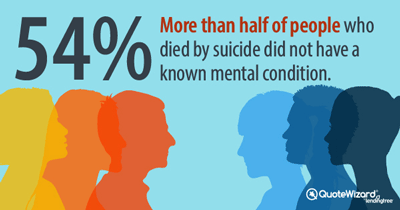More than 90 percent of people who died by suicide showed symptoms of mental health conditions, according to a new QuoteWizard report, released in September, which is Suicide Prevention Month.
The report notes that 59 percent of U.S. adults with a mental health condition did not receive care over the past year.
The report also found that Maryland ranks 38th for the prevalence of mental illness and has the 14th-highest access to mental health care in the country, ranking it with a composite score of 2nd-best overall for its lower mental illness rate and higher access to care.
Also, among the key findings:
- •States with higher access to mental health care tend to have a lower prevalence of mental health illness (North Dakota, Maryland, and New Jersey, among others).
- •Only 41 percent of adults with a mental health condition received mental health services in the past year.
- •The low rate of access leaves over 24 million people with mental health conditions untreated.
- •12.2 percent (over 5.3 million) of adults with mental illness remain uninsured, which can be a roadblock for those looking for care.
- •Over 9.8 million adults seriously thought about suicide – an increase of 200,000 people from last year’s data set.
QuoteWizard
“There are many programs and campaigns that utilize social media as a tool to reach more people in an effort to help those in need to seek help,” said QuoteWizard Analyst Adam Johnson. “Social media is also being used in ways to destigmatize mental illness and bring awareness to Suicide Prevention Month. In addition to the traditional call-in prevention hotline, they have set up texting options as well.”
With the stigma that is often attached to mental illness prevalent in minority communities, Johnson says individuals from racial and ethnic minority groups still are less likely to receive mental health care.
For example, in 2015, among adults with any mental illness, 48 percent of whites received mental health services, compared with 31 percent of blacks and Hispanics, and 22 percent of Asians,” Johnson said, quoting mental health statistics.
When asked whether there was anything specific to Baltimore that could be shared about mental illness and overall mental health, Johnson said that approximately 175,000 people in Baltimore City currently live with a mental health condition, he responded, “About one-third of Baltimore households earn less than $25,000; these households are more likely to be uninsured and have unmet medical needs.”
While the focus of the study was on mental health care access across the nation, some states are better than others when it comes to the number of care facilities and programs for its residents, according to Johnson.
“What we learned is overall most states are lacking,” he said.
Some staggering numbers researchers found include: One in five adults experience a mental illness in a given year. With so many Americans affected by mental illness, lack of access to health care can often be a more substantial source of the problem.
“The consequences for the lack of treatment have economic impacts, but more seriously, it can cause harm to individuals with mental illness,” Johnson said.

